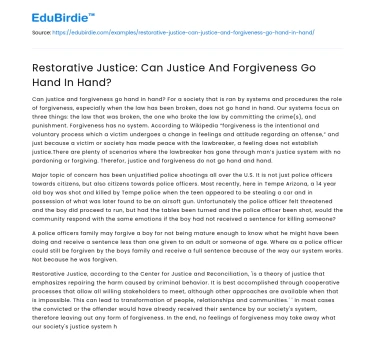Introduction
Restorative justice is an innovative approach to addressing crime and wrongdoing that focuses on repairing harm and fostering healing rather than merely punishing offenders. As a transformative alternative to the traditional retributive justice system, restorative justice emphasizes accountability, reconciliation, and the empowerment of victims and communities. This essay explores whether justice and forgiveness can coexist within the framework of restorative justice, examining its potential to deliver both justice and forgiveness in a single process. By delving into real-life cases and scholarly perspectives, this essay aims to elucidate the complex dynamics at play within restorative justice processes. It also addresses the reservations and criticisms posed by opponents who argue that such approaches may compromise the moral imperatives of justice. Ultimately, this analysis seeks to provide a nuanced understanding of whether restorative justice can indeed harmonize the seemingly disparate concepts of justice and forgiveness.
Restorative Justice: Foundations and Principles
Restorative justice is rooted in the premise that crime causes harm to individuals and communities, and thus, justice should focus on repairing that harm. This approach is guided by principles of inclusivity, dialogue, and mutual respect, involving not just the victim and the offender but also the wider community in the justice process. According to Zehr (2002), a leading scholar in the field, restorative justice seeks to "put right" the wrongs and foster healing for all parties involved. A classic example of restorative justice is the Truth and Reconciliation Commission (TRC) in South Africa, which aimed to address the atrocities of apartheid by facilitating open dialogue between perpetrators and victims. The TRC provided a platform for victims to voice their suffering and for offenders to acknowledge their wrongdoings, thereby fostering a sense of justice intertwined with forgiveness.
However, the integration of justice and forgiveness within restorative justice is not without challenges. Critics argue that restorative justice may downplay the severity of crimes and provide inadequate consequences for offenders. According to Daly (2002), the focus on dialogue and reconciliation can sometimes overshadow the need for proportionate accountability. Yet, proponents contend that restorative justice does not negate accountability; rather, it reframes it. Offenders are encouraged to take responsibility in a meaningful way, often agreeing to make amends directly to the victim or community, thus aligning justice and forgiveness. This participatory form of justice can empower victims, offering them closure and a sense of justice that traditional punitive measures might not provide.
Case Studies: Successes and Challenges
Examining specific case studies can further illuminate how restorative justice operates in practice and its potential to reconcile justice and forgiveness. One notable example is the restorative justice program implemented in New Zealand's youth justice system. This program, which involves family group conferences, has been successful in reducing recidivism rates and promoting victim satisfaction. According to a report by Maxwell and Morris (2006), over 80% of victims who participated in these conferences felt that justice had been served, and many expressed a sense of forgiveness towards the offender.
Despite these successes, restorative justice programs do face significant hurdles. Cultural biases, power imbalances, and the varying willingness of participants to engage in the process can affect outcomes. For instance, in some cases, victims may feel pressured to forgive or may not feel adequately supported throughout the process. Furthermore, the effectiveness of restorative justice can vary depending on the nature of the crime and the individuals involved. Serious crimes, such as sexual offenses, may present additional ethical and practical challenges, as noted by Cossins (2008). These challenges highlight the need for careful implementation and ongoing evaluation of restorative justice programs to ensure they deliver both justice and forgiveness effectively.
Counter-Arguments and Rebuttals
Critics of restorative justice often argue that it may compromise the fundamental principles of justice, such as deterrence and retribution. They claim that restorative justice prioritizes forgiveness at the expense of justice, potentially undermining the rule of law. However, supporters argue that restorative justice does not replace traditional justice systems but rather complements them by addressing the limitations of retributive justice. As Braithwaite (2002) suggests, restorative justice can work alongside conventional justice systems to provide more holistic approaches to crime and punishment. Restorative justice also emphasizes voluntary participation, ensuring that forgiveness is not coerced but rather emerges from genuine dialogue and understanding.
Furthermore, empirical evidence supports the effectiveness of restorative justice in fostering rehabilitation and reducing recidivism rates. A meta-analysis by Latimer et al. (2005) found that offenders who participated in restorative justice programs were significantly less likely to reoffend compared to those who went through traditional justice systems. This suggests that restorative justice can deliver meaningful justice outcomes while encouraging forgiveness and healing. By addressing both the needs of victims and the rehabilitation of offenders, restorative justice offers a balanced approach that aligns justice with forgiveness.
Conclusion
The exploration of restorative justice reveals that justice and forgiveness are not mutually exclusive but can indeed coexist within this transformative framework. By focusing on repairing harm and fostering dialogue, restorative justice enables a process where offenders can take meaningful accountability, victims can find closure, and communities can heal. While challenges and criticisms persist, the successes of restorative justice programs in various contexts demonstrate its potential to harmonize justice and forgiveness effectively. As societies continue to grapple with the complexities of crime and punishment, restorative justice presents a compelling alternative that seeks to balance the moral imperatives of justice with the human capacity for forgiveness. Ultimately, the integration of justice and forgiveness within restorative justice reflects a profound understanding that true justice is not just about punishment but also about healing and reconciliation.






 Stuck on your essay?
Stuck on your essay?

